
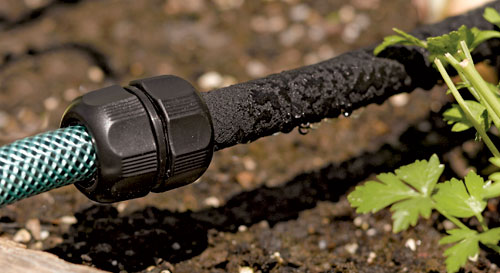
Soaker hoses, such as the Snip-n-Drip Soaker System
, can be used with timers to make sure garden beds get watered while you’re away.
A week’s vacation at the beach might be a welcome break for you, but the absence of a doting gardener can wreak havoc on your indoor and outdoor plants. Here are some tools, tips and techniques that will help plants thrive while you’re away, so you can come home from your trip to healthy gardens and happy houseplants. And, if you live in a dry climate, consider these tips best practice — even if you’re not out of town.
Outdoor Solutions
As you plan your departure, consider the following:
- How long will you be away? If you’re going away for a weekend, most garden plants will survive if you give them a good soaking just before you leave. Any longer and you may need to take action to keep plants healthy.
- What types of plantings do you have? Newly seeded vegetable beds and lawns, hanging baskets and small pots may need daily watering and will require more preparation. Established plants in garden beds and those in large planters are more resilient.
- What’s the weather forecast? If predictions call for a spell of hot, sunny weather, you’ll want to make sure your plants are especially well prepared.
Plants in different growing situations will need individual watering plans. If you don’t have a trusted gardening friend to visit your plants once or twice a week, try these tips for keeping containers and gardens happy.
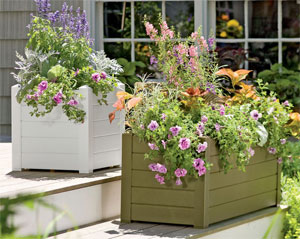
Terrazza Self-Watering Planters have hidden reservoirs to extend the time between waterings.
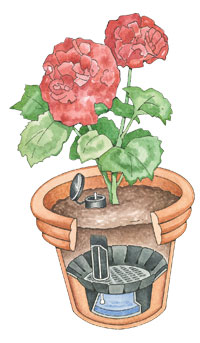
With the Self-Watering Conversion Kit, you can add self-watering convenience to any pot or planter.
Pots and Planters
- Move pots and hanging baskets to a spot that’s shaded most of the day, especially in the afternoon. If no other shade is available, move them into the garage. A week or so of reduced light may temporarily cause leggy growth or reduced flowering, but plants will recover. Be mindful, however, that removing planters from their usual location, combined with accumulating newspapers or mail, could signal that you’re out of town.
- Group containers close together to create a humid microclimate that helps conserve water. Applying a layer of bark mulch to the soil surface of containers also helps hold in moisture.
- Sink smaller pots into the soil to help keep roots cool and conserve moisture.
- Consider moving plants into self-watering planters. These planters have a water reservoir that can provide plants with a source of water for several days to several weeks, depending upon the size of the planter and reservoir, the age and type of plants, and the weather. Our Self-Watering Conversion Kits allow you to convert most pots into self-watering planters.
- Water plants thoroughly before you leave. Soak pots and hanging baskets in a Tubtrug or bucket of water to ensure that moisture penetrates to the center of the pot.
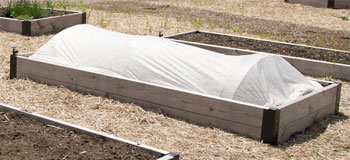
This bed of seedlings is protected from intense summer sun with a covering of Garden Fabric.
Garden Beds and Landscape Plants
- Combine our innovative Snip-n-Drip Soaker Systems with a programmable timer
to create convenient and automatic vacation watering solutions. - At least a few days before you leave, set up your soaker systems and experiment with different timer settings to see what works best for each situation. A newly planted row of seeds might need a half-hour of watering each morning, for example, while a row of established blueberry shrubs would be better off with a deep, 2-hour watering once a week.
- Apply a layer of mulch around landscape and vegetable plants. Grass clippings, bark mulch, leaf mold and compost will shade the soil and help retain moisture.
- Water the root zones of vulnerable plants deeply just before you leave. Allow the water to soak in slowly to a depth of at least 6″ to 8″.
- In windy locations, cover vegetable plants with Summerweight Garden Fabric to protect them from drying winds and hold moisture in the soil. You can cover entire garden rows or wrap it around individual support cages.
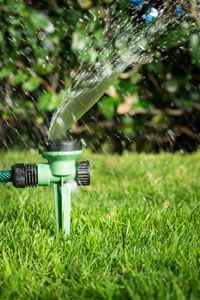
Snip-n-Spray Garden and Landscape Sprinkler System
Lawns
- Lawns often need regular watering, especially in sandy soils. Our Snip-n-Spray Garden and Landscape Sprinkler System, combined with a programmable timer
, lets you create a customized system for watering lawns, perennial beds and gardens. The system includes 50 feet of hose and five sprinkler heads. - Newly seeded lawns require frequent — even daily — watering, especially during hot weather. Established lawns, on the other hand, benefit from a deep, weekly soaking. Use a timer to set the right frequency and duration for your situation.
- Mow your lawn just before you leave, but cut it a bit higher than you normally would. Taller grass is more resistant to drought because it shades the soil, which prevents evaporation. Leave the clippings in place to add moisture-retentive organic matter to the soil.
More Options
- If you have someone watering in your absence and you want to make the job easier for them, position our AquaCone® Watering Devices or more decorative Terra Cotta AquaCone® Watering Device at the base of garden plants or in containers. Ask the person to fill each AquaCone a few times per week, or as often as you think necessary. Both types of AquaCone apply water directly to roots and minimize evaporation. They release all their water within a few minutes, so they may need to be filled frequently while you’re away.
- If you plan to travel frequently or live in a drought-prone area, consider mixing Terra-Sorb crystals into your potting soil. The crystals can be used in planters and even in garden beds. The super-absorbent hydrogel crystals, made from potassium-based polymers, start out the size of coarse sand, and then swell to the size of a blueberry when moistened. As the soil around them dries, the crystals shrink, releasing their water to the soil. The crystals swell so dramatically when moistened, it’s important to follow the recommended application rate carefully to avoid overwhelming containers.
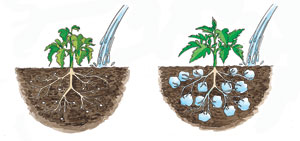
Nontoxic Terra Sorb crystals absorb up to 200 times their weight in water, then release it gradually as plants need it.
Indoor Solutions
- If you’ll only be gone for a few days, simply move your houseplants out of direct sunlight — close the shades — or shift them toward the center of the room. This will slow growth and reduce moisture loss. Water thoroughly right before you depart, making sure that moisture penetrates to the center of the root ball. If you turn your air conditioning down or off while you’re away, move houseplants to a part of the house where the air temperature will be relatively cool and constant.
- Many houseplants will thrive in a temporary bathtub greenhouse — especially low-light, tropical foliage plants. Leave the light on in the bathroom, and you should return to a tub full of healthy plants. Here’s how to do it:
- Line the tub with a large plastic sheet to make clean-up easier.
- Place several layers of newspapers on top of the plastic, lining the bottom of the tub.
- Place plants on the newspapers and turn the shower on long enough to wet the newspaper.
- Pull the shower curtain closed to help retain moisture.
- If someone will be tending your houseplants while you’re away, take the time to educate them on the amount of water your plants need. When it comes to houseplants, too much water can be as troublesome as too little. Ask them to tip excess water out of saucers, for example.
- Organize houseplants by watering needs — separate the cactus from the African violets. It’s easier for your vacation helper to water groups of plants than to memorize individual plants’ needs.
While nothing can replace an attentive gardener when it comes to keeping plants healthy, with some planning and, ideally, a helpful gardening friend, you can come home from your vacation to thriving plants, indoors and out.